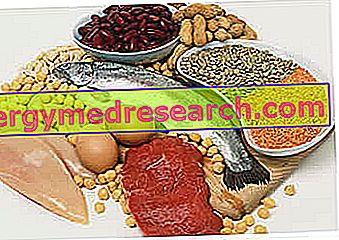The protein diet for weight loss, better defined as IPER-protein, is a diet based on the increase in food proteins.

As anticipated, the protein diet is based on the increase (percentage or absolute) of food proteins, whether they come from foods or from food supplements.
I believe it is now consolidated ... and in common agreement between the professionals ... that, for the purpose of weight loss, is essential:
- Introduce less energy than that expense
- Increase the metabolism and improve the functionality of the organism with motor activity
- Make the most of the interaction between energy nutrients and metabolism
With respect to all this, the protein diet for weight loss intervenes on several fronts:
- It adequately supports the plastic needs of an organism in training
- Significantly reduces glycemic and insulin spikes in the postprandial period compared to a diet rich in refined carbohydrates (typical of overweight people)
- It has a specific dynamic action (ADS) higher than the traditional balanced diet
- Promotes the onset of the post-prandial sense of satiety, thanks to the increased release of gastrointestinal hormones, such as cholecystokinin
Downsides
On the other hand, the protein diet is NOT always to be considered the most suitable system for weight loss, indeed! It is true that it represents a simple diet to manage and effectively reduce weight, but it is also true that it has a certain number of negative aspects. These include:
- High intake of nitrogen groups to be disposed of; this determines a surplus of hepatic and renal work (very bad characteristic for infants and the elderly, as well as for hypersensitive subjects or, much worse, for those suffering from disorders of the organs concerned)
- Possible keto-acidosis, especially in conjunction with a drastic reduction in carbohydrates; this lowering of blood pH, in addition to determining a lower efficiency of the central nervous system, causes an increase in potentially dehydrating renal filtration; NB . Ketone bodies are toxic to all body tissues
- Possible deterioration of the PRAL
- Possible increase in saturated fatty acids and dietary cholesterol, with an increased risk of metabolic alterations
- Possible glucose insufficiency in sports performance that induces an increase in muscle catabolism; What does it mean, I say, to increase plastic nutrients ... if we foster tissue catabolism in parallel?
- Possible insufficiency of dietary fiber
- Possible gastric fatigue and digestive disorders
- Possible alteration of intestinal physiological bacterial flora
Etc.
The word "Possible .." at the beginning of each point described above depends on the technique used to prepare the protein diet to lose weight (whether with the percentage increase in proteins or with the absolute increase of the same) and by respect or less than the rules for a healthy diet (in terms of consumption of fruit, vegetables, fish, water, red meat, simple sugars, frequency of meals, etc.).
Percentage increase in proteins
The PERCENTAGE increase in protein in the protein diet for weight loss is very simple to apply; first of all we specify that, in order to lose weight, a diet should provide less energy than necessary, precisely 70% of the total energy requirement (for example, in a NORMO-caloric diet of 2860kcal, 70% of energy equals about a 2000kcal IPO-caloric ).
To distribute the IPO-caloric energy in the various energy nutrients it is essential:
- Calculate 25% of the energy in lipids (eg, in a 2000kcal diet - 500kcal of lipids that are equal to 93g)
- Calculate 1.0 or 1.5g of protein per kg of physiological weight (eg, for a subject that should weigh 60kg - 60 or 90g of protein, which is equal to 240kcal or 360kcal)
- Calculate the carbohydrates from the remaining energy: subtracting both the lipid energy and the protein energy from the 2000kcal (eg: 2000kcal - 500kcal - 240kcal or 360kcal = 1260kcal or 1140kcal, which are 336g or 304g of carbohydrates).
If we wanted to compare the nutritional balance of the NORMO-caloric diet (therefore, before removing the energy needed for weight loss) to that of the IPOcalorica (equal to 70% of the NORMOcalorica), we would observe that THE ONLY FRACTION OF NUTRIENTS THAT REMAIN QUANTITATIVELY EQUAL IS THAT PROTEIN, since it is calculated on the basis of the desirable physiological weight and NOT on the energy. However, by comparing the energy share of the proteins to the overall energy, it can be seen that these take on a decidedly greater importance in the IPO-caloric diet due to the PERCENTAGE increase of the same (for example, 90g of proteins for the NORMO-caloric of 2860kcal represent 12.6 % of energy, while 90g of proteins for the relative IPOcalorica of 2000kcal represent 18% of the energy).
Ultimately, the percentage increase in protein in the protein diet to lose weight (if you use the calculation method with protein coefficient * kg of desirable physiological weight) is INESORBILE.
Absolute increase in proteins
The absolute increase in protein in the protein diet for weight loss is not much more complex to understand, although (in my opinion) it is less advisable because it is potentially unbalanced from a nutritional point of view; let's start by pointing out that the absolute increase (even definable QUANTITATIVE) of proteins ALWAYS corresponds to the percentage increase ... even if in decidedly larger proportions!
The absolute or quantitative increase in protein in the protein diet to lose weight, unlike the previous method, uses a protein coefficient * kg of desirable physiological weight GREATER than the NORMALcalic (eg, if the NORMO-caloric proteins equal to 2860kcal are calculated by a coefficient of 1.0g * kg of desirable physiological weight [ie, 1.0g * 60kg = 60g], in the IPO-caloric protein diet for weight loss from 2000kcal with ABSOLUTE increase in proteins, these can be calculated by a coefficient of 2.0g * kg of desirable physiological weight [ie, 2.0g * 60kg = 120g].
Unlike the previous one, which keeps the protein weight constant in parallel with an energy reduction, this method INCREASES it quantitatively by using a coefficient * kg GREATER.
Summing up:
- Protein diet method for weight loss, IPOcalorica, with protein percentage increase: eg, 1.0g * 60kg = 60g out of a total of 2000kcal (18% of energy)
- Protein diet method for weight loss, IPOcalorica, with absolute or quantitative increase in proteins: eg, 2.0gkg = 120g out of a total of 2000kcal (24% of energy).
Useful supplements
If the protein diet, although containing excess peptides, is fairly balanced in terms of recommended rations (vitamins and mineral salts), then no dietary supplement is necessary; otherwise, it is highly recommended to lean on your nutritionist or primary care physician in order to identify the correct administration of specific supplements.
NB . Usually, nutrition is more than enough to cover the plastic needs of a protein diet to lose weight; on the other hand, for ease of use or to optimize the management of the diet, it could be useful to use food supplements such as: protein bars and whey protein powder, casein or soy.
Example of a High Protein Diet for Weight Loss »



